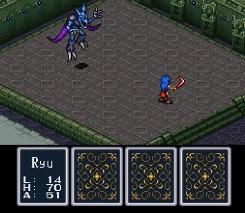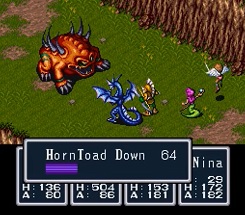
Breath of Fire
In 1993, Capcom surprised a lot of people by releasing an RPG on the SNES. The studio wasn't known for its role playing games, having focused instead on more action-oriented titles like the Mega Man series, various beat 'em ups, Street Fighter 2 and a host of others. Sure, there was Destiny of an Emperor, but few people played that game, and fewer still seem to remember it. So, when this game was released, people were pleasantly surprised to see that they were capable of making a decent game in this genre as well. During its heyday the game did fairly well for itself, and would go on to receive a number of sequels.Breath of Fire told the story of a boy named Ryu who would venture forth to become a warrior for his dragon clan. Centuries earlier, the various dragon clans were pitted against each other by the goddess Tyr. Eventually, a member of the Light Dragon Clan, and one of Ryu’s ancestors, would lead a group of brave souls to hunt down Tyr and confine her where she couldn’t cause any trouble. This brought about peace for a very long time, but as the years passed, the Dark Dragon Clan got thinking about world domination and would attempt to release Tyr from her prison to help them. As part of their plan, they would try to destroy the light dragons and Ryu. However, Sara, a sorceress among the light dragons (and Ryu's sister) would cast a spell that protects them, while she chases the dark dragons away. When Ryu and his friends are revived, Sara is gone, and now Ryu must go forth on his adventure to save the world and Sara.
In his travels, he meets many others with their own problems that he helps, leading to them joining him in his own quest. These include the angel-winged Nina, who becomes the party’s healer / support class, Bo, a fox man with a lot of offense-based abilities as well as the ability to bow hunt wild animals on the world map, and Karn, a thief with various lock picking and trap disarming skills, as well as the ability to temporarily fuse with other characters to create large beasts during battle. There is also the fishman merchant Gobi who joins the group and is able to transform into a giant fish allowing for sea travel. Next, there is Bleu, who is a black magic user that looks like a Naga. Rounding out the eventual full party are Ox who is an Ox man. He’s huge, and focuses on devastating melee attacks, and has the ability to bash through certain walls, then there is Mogu, a mole man who is, unsurprisingly, good at digging.
While the various party members fill fairly typical roles in combat, it was the extra abilities that they brought to the table, like hunting that made things a little more interesting, as JRPGs of the time weren’t doing this sort of thing just yet, and Breath of Fire was an early tentative step in that direction. It was a novel idea that would slowly appear more in the genre in coming years.
Combat itself was typical turn-based fare, with players either manually giving orders to party members telling them to attack, use spells or items, et cetera, or opting to just let the battle play out in auto mode, only interrupting if things got dicey. As mentioned earlier, some characters had some particularly interesting abilities like Karn, and Ryu eventually learns how to transform into a dragon temporarily for some extra beefy attacks, which was pretty darn cool for the time. It didn’t reinvent the wheel, but served its purpose. Generally trash mobs were no big deal, but boss fights could be interesting at least.
The biggest thing that hurt combat was that it happened a lot. This is a game that came out when random encounters were commonplace, and Breath of Fire didn’t hesitate to regularly subject people to yet another battle seemingly every three steps. Making matters worse was that a degree of grinding was also necessary in the game, as players had to gain levels and save up money to buy new equipment. Even though this was a regular occurrence in the genre at the time, Breath of Fire was particularly bad for this.
Aesthetically, the game looked respectable. It had nice, colorful sprite work, which the SNES was known for. As an interesting aside, it was actually Keiji Inafune of the Mega Man series who did all of the character design in Breath of Fire, which was quite a strong point in the game. The main characters were all anthropomorphic animals, and they looked really good both in game, as well as in official artwork.
Unfortunately, the music isn’t particularly great. The game had decent composers involved, and some of the music actually has a bit of a Mega Man feel to it, but much of it is quite repetitive. There are definitely other Capcom games of this period with far better soundtracks.
While this game did try to offer a few new ideas for the genre, at the end of the day, it is still quite dated, especially when it comes to combat. Fans of retro JRPGs will be fine, as it is business as usual for them. However, those who aren’t all that into the old fashion approach to combat, gearing, and storytelling here would probably be better off taking a pass on this game. The game did get an updated version on the GBA a few years later with quality of life improvements but even then, it still has a lot of random encounters. Fans of JRPGs will likely always have a special place in their heart for the Breath of Fire games, but newcomers should go in prepared for the fact that the game has its fair share of dated elements.
- IroIro
September 22, 2020
More RPGs We've Discussed:
- Emerald Dragon SNES Review- Phantasy Star II Mega Drive Review
- Record of Lodoss War: Advent of Cardice Dreamcast Review
Genre: RPG
Developer: Capcom
Publisher: Capcom
Released: 1993

SNES Cover Art

Ryu and Nina in town

A boss battle

Ryu in his dragon form